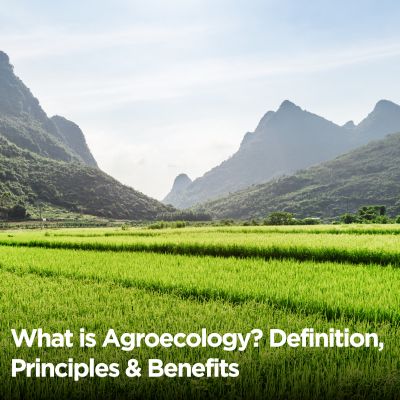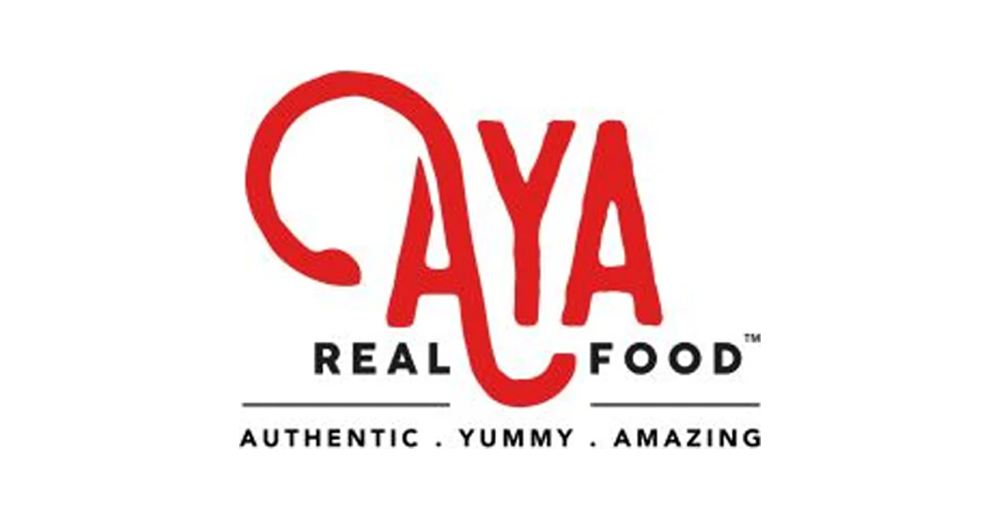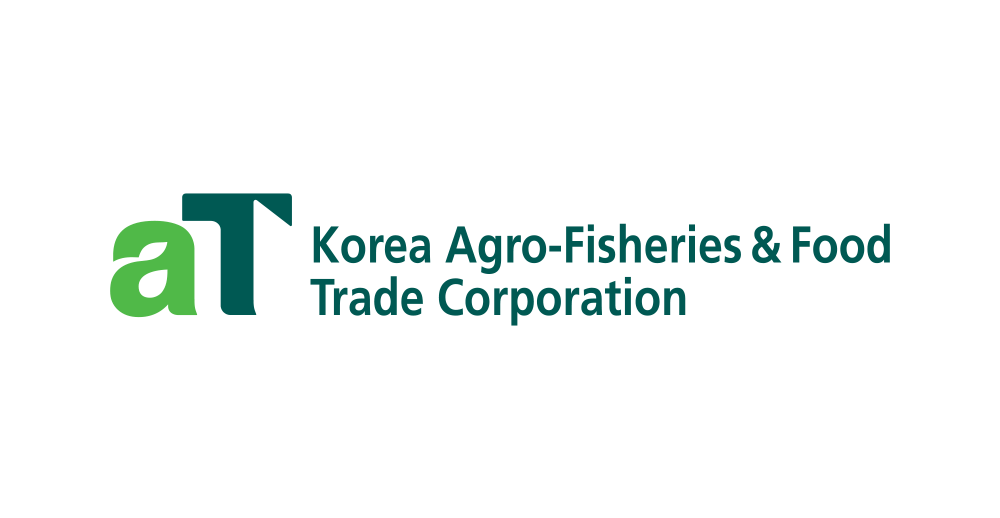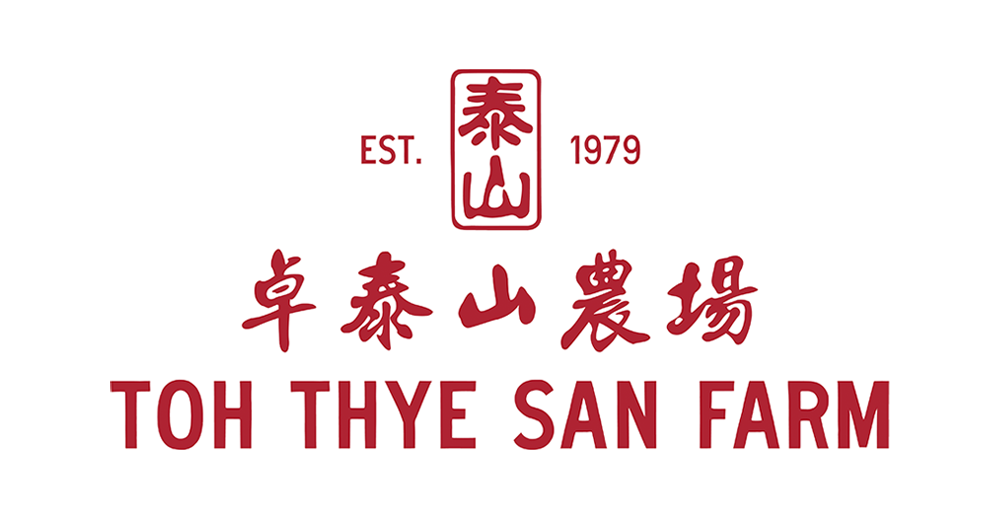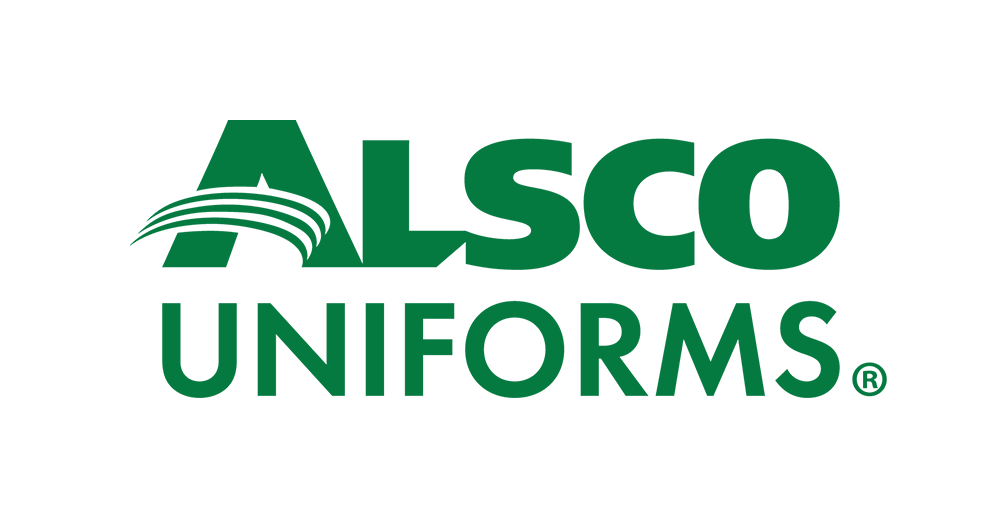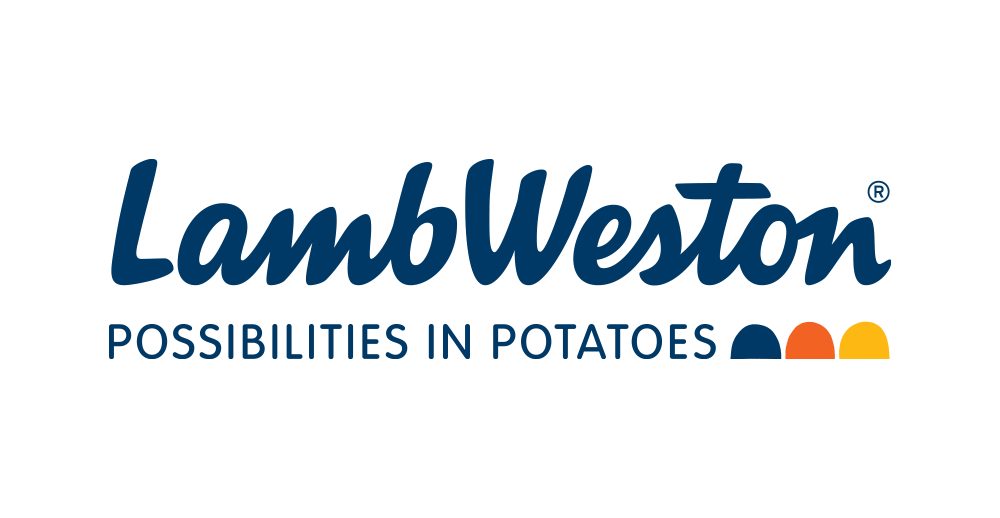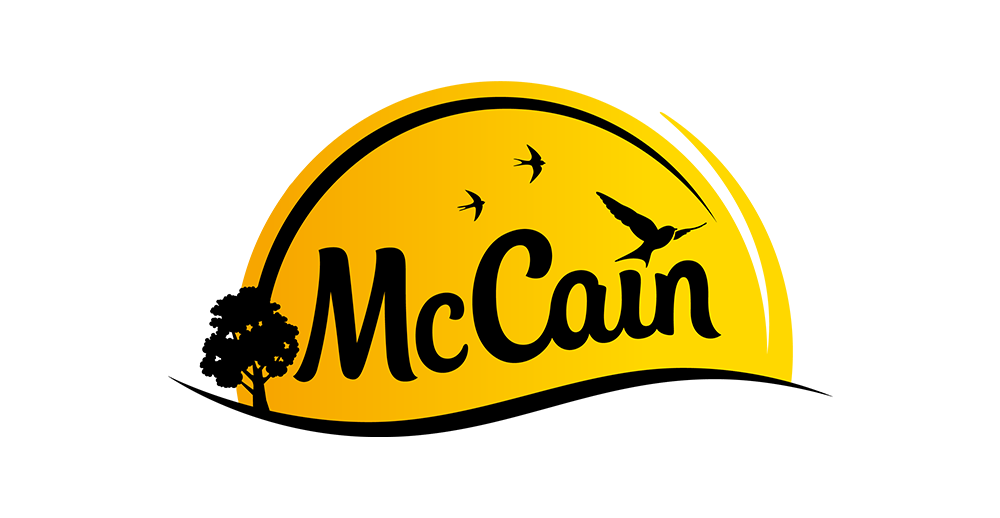A circular food economy is a system in which food resources are produced, consumed, and managed in ways that eliminate waste, regenerate natural ecosystems, and keep nutrients cycling continuously.
Unlike the traditional linear food model, which operates on a “take, make, dispose” basis, the circular approach focuses on minimizing resource use, reducing waste, and enhancing soil and environmental health.
The linear model typically results in the overuse of natural resources, high levels of food waste, and negative environmental impacts.
By keeping materials in use and restoring biological systems, a circular economy in food supports long-term sustainability, strengthens food security, and helps combat climate change.
Practices like regenerative farming, nutrient cycling, composting, and food waste valorization are primary strategies that move the food sector toward a healthier and more resilient future.
How Does It Work?
The circular economy in food operates on several important principles aimed at creating a sustainable, closed-loop system. The main principles include:
Waste Reduction at Every Stage
Minimizing waste is a core aspect of a circular food system from production to consumption. The goal is to reduce food loss at all stages — on the farm, during processing, in retail, and at home.
Instead of discarding surplus or spoiled food, circular models encourage finding ways to reuse or repurpose it, reducing waste in landfills.
Recycling of Nutrients
Recycling nutrients is essential in circular food systems. Composting, anaerobic digestion, and other organic waste recycling methods convert food scraps into valuable resources, such as fertilizers or biogas.
These processes help return vital nutrients to the soil, enriching it for future crops, and closing the biological loop. In this context, nutrient cycling ensures that the life cycle of biological materials remains continuous, enriching the regenerative food system.
Integration of Regenerative Agriculture
Regenerative agriculture is an essential element of a circular food economy. Rather than just focusing on sustainability, this method actively restores soil health, enhances biodiversity, and strengthens water retention.
Farmers use crop rotation, cover cropping, and agroforestry to regenerate the land, leading to more resilient agricultural systems. Integrating these practices enhances the food system’s long-term productivity and sustainability while supporting healthier ecosystems.
The Circular Loops: Farm → Consumer → Recovery → Farm
The circular economy in food relies on a closed-loop model where nutrients flow through various stages. In this loop, materials and energy are continuously reused. Starting at the farm, food is grown in a way that supports regeneration and sustainability.
It then moves to the consumer, where consumption happens sustainably, and any waste is sent for recovery through composting or recycling. Finally, these recovered materials return to the farm, replenishing the soil and enhancing future crop production.
Biological vs. Technical Cycles
While the biological cycle focuses on organic materials (such as food scraps, plant residues, and manure) that can be returned to the soil, the technical cycle involves materials like packaging and non-biodegradable waste designed for reuse, recycling, or repurposing.
In a circular economy, the biological cycle is essential for nutrient cycling, while the technical cycle ensures the sustainability of non-biodegradable materials, creating a fully integrated system of sustainable food economies.
Benefits of a Circular Food System

A circular food system brings multiple benefits, from environmental improvements to economic growth. This model creates lasting positive impacts on the planet and society by rethinking how food is produced, consumed, and recovered.
Studies indicate that a circular food economy could generate $2.7 trillion in savings by 2050, emphasizing its financial and environmental potential. It supports sustainability and creates new opportunities for economic resilience and a more efficient food system.
1. Reduced Environmental Impact
Circular agriculture emphasizes closed-loop practices that reduce emissions, limit the use of synthetic inputs, and restore natural ecosystems.
Techniques like composting, cover cropping, and integrated pest management reduce dependency on harmful chemicals and enhance soil health. This reduces pollution in waterways and lowers greenhouse gas emissions associated with traditional farming.
2. Lower Food Loss and Waste
One of the main pillars of circular food systems is reducing food waste. This includes better inventory management, food recovery initiatives, and food waste valorization — converting waste into valuable products such as bioenergy or animal feed.
These strategies support zero-waste food models, keeping food in use for as long as possible and easing the pressure on landfills and incineration systems.
3. Improved Food Security
Circular and regenerative food systems strengthen local supply chains and reduce dependency on vulnerable global distribution networks. Practices that restore soil fertility and improve water retention help ensure reliable food production, even in climate change.
By using resources more efficiently and creating decentralized systems, circular models help communities become more self-reliant and resilient.
4. New Circular Economy Jobs and Business Models
Circular food systems open doors for innovation and entrepreneurship. From startups like ReGrained (which turns spent grains into snacks) to larger-scale nutrient recovery services, new circular economy jobs are emerging across agriculture, logistics, food processing, and waste management.
This approach promotes food system circularity while creating inclusive economic opportunities and encouraging sustainable consumer behavior.
Real-World Examples
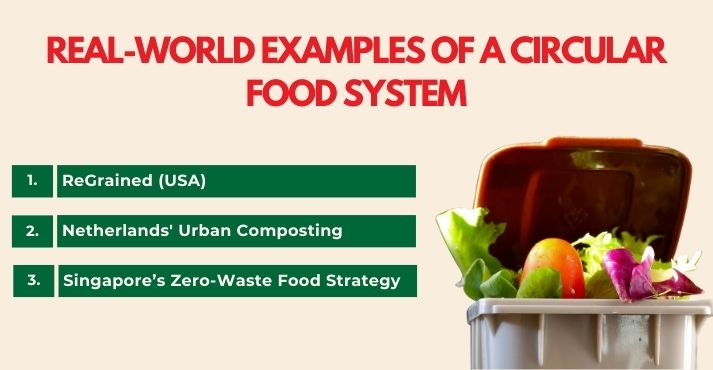
Several innovative initiatives worldwide are bringing circular food systems to life, proving that circularity is achievable and scalable.
- ReGrained (USA): Based in San Francisco, ReGrained upcycles brewer’s spent grain — a by-product of beer production — into nutrient-rich snack bars and baking flour. Using food waste valorization, the company extends the life cycle of ingredients that would otherwise be discarded, turning them into new, marketable food products.
- Netherlands’ Urban Composting Hubs: Dutch cities run composting programs as part of their circular agriculture efforts. Residents separate food waste, which is processed locally. The compost produced supports urban farms and green spaces. This creates a loop of consumption, recovery, and renewal — an example of food system circularity.
- Singapore’s Zero-Waste Food Strategy: Singapore is developing closed-loop food systems to tackle food waste. Collected scraps from homes and businesses are turned into biogas and compost through anaerobic digestion. These outputs support regenerative food systems and reduce reliance on imported resources.
Challenges and Considerations
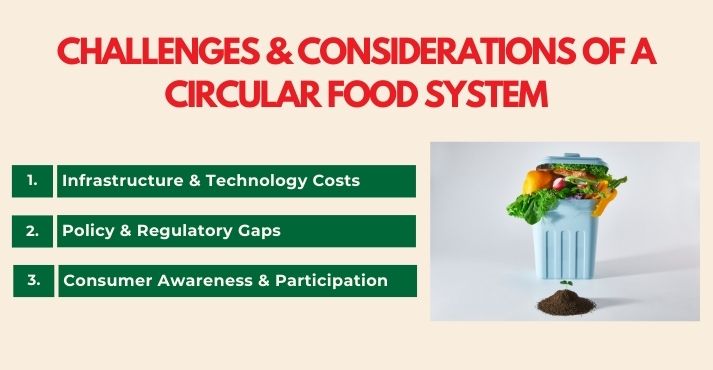
While circular food systems offer numerous advantages, several challenges must be addressed for effective implementation:
1. Infrastructure and Technology Costs
Setting up the infrastructure required for circular food systems, such as composting facilities, anaerobic digestion plants, and nutrient recovery systems, can be capital-intensive.
Small-scale farmers and local producers may face challenges in affording the necessary technologies.
The upfront costs associated with creating efficient systems for food waste recovery and resource recycling can also discourage investment, especially in developing regions with limited access to these technologies.
2. Policy and Regulatory Gaps
Despite growing support for circular food systems, policy frameworks that promote sustainability and waste reduction are not yet universally implemented.
Regions with weak waste management regulations or a lack of financial incentives can hinder the adoption of circular practices.
Without a cohesive policy environment, such as those advocated by organizations like the FAO, the transition to regenerative and sustainable food models can be slow and fragmented, limiting their potential impact.
3. Consumer Awareness and Participation
Public education is a major hurdle in the widespread adoption of circular food systems. Many consumers are unaware of the environmental benefits of composting, recycling, or supporting regenerative food systems.
This lack of awareness can lead to insufficient participation in waste reduction programs. According to the Ellen MacArthur Foundation, active consumer participation is essential for food system circularity.
Encouraging sustainable practices requires a shift in public behavior, from how food is consumed to how it is disposed of.
Frequently Asked Questions (FAQs)
What is the goal of a circular food economy?
A circular food economy aims to create a regenerative system where resources are replenished, food waste is minimized, and nutrients are cycled back into the environment.
It focuses on sustainability, reducing the environmental impact of food production, and enhancing long-term food security.
How is it different from traditional systems?
Traditional food systems follow a “take–make–waste” model, where resources are consumed and discarded, contributing to waste and resource depletion.
Circular food systems, on the other hand, emphasize closing the loop by reusing materials, recycling nutrients, and reducing overall waste, leading to more sustainable practices.
Can businesses adopt circular practices easily?
While circular practices require initial investment and strategic planning, scalable models are available for small and large enterprises.
As technology advances and policies support sustainability, more businesses can integrate circular food practices into their operations, leading to long-term efficiency and environmental benefits.
Conclusion
A circular economy in food focuses on closing the loop — recycling nutrients, minimizing waste, and building regenerative food systems that benefit both the planet and people.
By adopting these circular principles, we can create a food system that sustains resources, restores ecosystems, cuts emissions, and helps mitigate the impacts of climate change.
Additionally, circular food systems can make food production more resilient and adaptive, which is crucial for addressing the challenges of global food insecurity.
Transitioning to circular food systems is essential for long-term sustainability and economic resilience.
As food production shifts toward more circular models, greater opportunities exist to reduce waste, improve local economies, and boost food security worldwide.
As individuals, businesses, and governments continue to explore innovative ways to implement circular practices, staying informed and actively participating in these changes will ensure a thriving and sustainable future for future generations.



